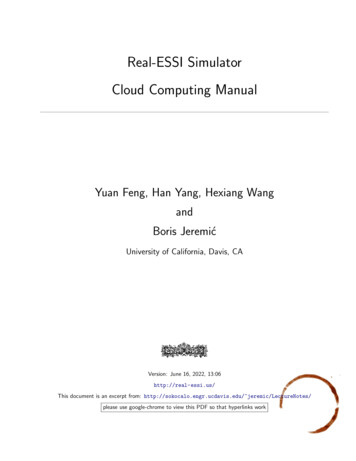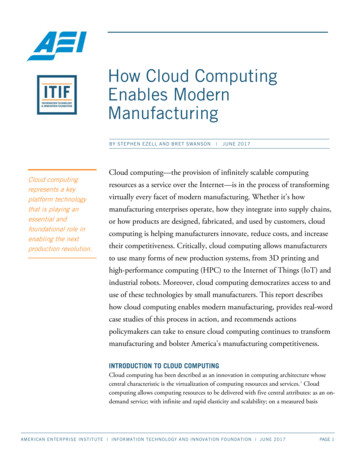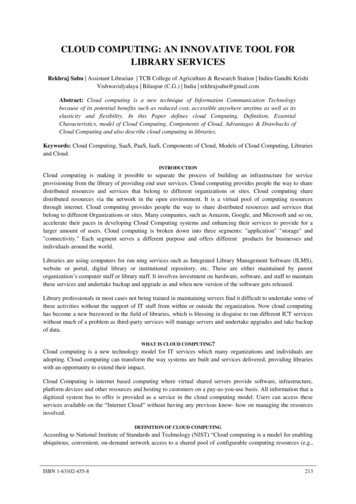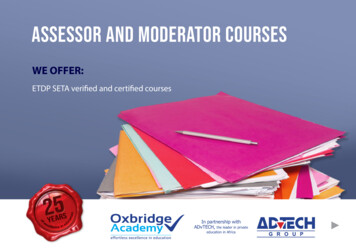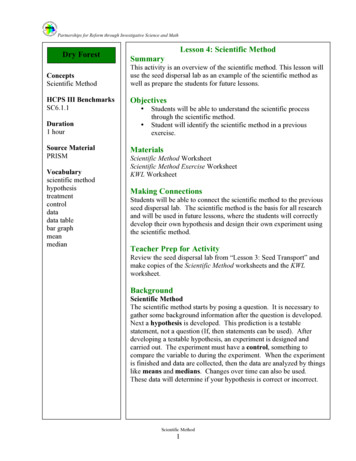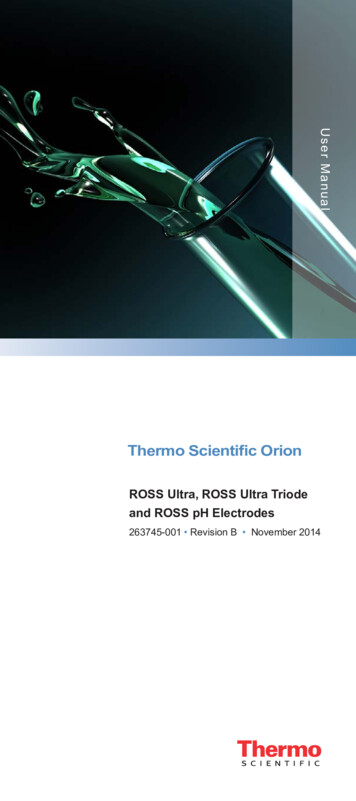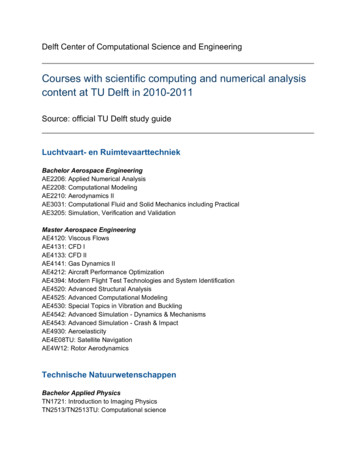
Transcription
Delft Center of Computational Science and EngineeringCourses with scientific computing and numerical analysiscontent at TU Delft in 2010-2011Source: official TU Delft study guideLuchtvaart- en RuimtevaarttechniekBachelor Aerospace EngineeringAE2206: Applied Numerical AnalysisAE2208: Computational ModelingAE2210: Aerodynamics IIAE3031: Computational Fluid and Solid Mechanics including PracticalAE3205: Simulation, Verification and ValidationMaster Aerospace EngineeringAE4120: Viscous FlowsAE4131: CFD IAE4133: CFD IIAE4141: Gas Dynamics IIAE4212: Aircraft Performance OptimizationAE4394: Modern Flight Test Technologies and System IdentificationAE4520: Advanced Structural AnalysisAE4525: Advanced Computational ModelingAE4530: Special Topics in Vibration and BucklingAE4542: Advanced Simulation - Dynamics & MechanismsAE4543: Advanced Simulation - Crash & ImpactAE4930: AeroelasticityAE4E08TU: Satellite NavigationAE4W12: Rotor AerodynamicsTechnische NatuurwetenschappenBachelor Applied PhysicsTN1721: Introduction to Imaging PhysicsTN2513/TN2513TU: Computational science
TN2780-HT: Honours Class Fysische TransportverschijnselenBachelor Molecular Science & TechnologyIMM: Introduction to Multiscale ModelingMQM: Molecular Quantum MechanicsMaster Applied PhysicsAP3081TU G: International Masters Course on Computational PhysicsAP3171 D: Advanced Physical Transport PhenomenaAP3551: Computational Multiphase FlowAP3561: Turbulent Reacting FlowsExtern InstituteUL38: Stellar dynamicsMaster Chemical EngineeringCH3131: Applied Numerical MathematicsCH3421: Computational Transport PhenomenaCH3671: Molecular SimulationMaster Life Science and TechnologyLM3761: Numerical Methods, Modeling & Simulation TechniquesMaster NanoscienceNS3621: Quantum Information ProcessingWerktuigbouwkunde, Maritieme Techniek & TechnischeMateriaalwetenschappenBachelor Mechanical EngineeringWB1424ATU: Turbulence AMaster Mechanical EngineeringME1600: Reliability and Uncertainty Models in Engineering MechanicsWB1416: Numerical Methods for DynamicsWB1428-1, -3: Computational Fluid DynamicsWB1440: Eng. Optimization: Concept & ApplicationsWB1441: Engineering Optimization 2WB1443: Matlab in Engineering MechanicsWB2454-07: Multiphysics Modelling using COMSOLWB4421: Gas Turbine Simulation/ApplicationMaster Biomedical Engineering
BM1200: Computational Mechanics of Tissues and ImplantsMaster Materials Science and EngineeringMS3031: Computational Materials ScienceMS3412: Processing of MetalsMS4131NS: Solid State Physics 2Master Marine TechnologyMT523: Numerical Methods for MTMT524: Hydromechanics of Special Ship TypesMT815: Construction and Strength, Special SubjectsMT830: Applications of the Finite Element MethodMaster Offshore EngineeringOE4630 D1, D2, D3, D4: Offshore HydromechanicsMinors WerktuigbouwkundeWB3600: Computational Engineering ProjectWB3663: ModelleertechniekenCiviele Techniek en GeowetenschappenMaster Civiele TechniekCT4143: Shell Analysis, Theory and ApplicationCT4180: Plate Analysis, Theory and ApplicationCT4310: Bed, Bank and Shoreline ProtectionCT4340: Computational Modelling of Flow and TransportCT4350: Numerical Soil MechanicsCT4380: Numerical Modelling of Geotechnical ProblemsCT4801: Transportation and Spatial ModellingCT5123: Introduction to the Finite Element MethodCT5142: Computational Methods in Non-linear Solid MechanicsCT5144: Stability of StructuresCT5146: Micromechanics and Computational Modelling of Building MaterialsCT5148: Computational Modelling of StructuresCT5315: Computational HydraulicsCT5802-09: Advanced Transportation ModellingMaster Applied Earth SciencesEMC-H/MM: Numerical Mine ModellingElektrotechniek, Wiskunde en Informatica
Bachelor Applied MathematicsWI2604: Numerical Methods 1WI3097TU: Numerical Methods for Differential EquationsWI3097TU-c: Numerical Methods for Differential EquationsWI3097TU-p: Numerical Mathematics (Lab)WI3603: Numerical Methods 2Master Applied MathematicsWI4011: Computational Fluid DynamicsWI4012ta: Mathematics, Special SubjectsWI4014TU: Numerical AnalysisWI4017TU: Parallel ComputingWI4051TU: Introduction to Operation ResearchWI4054: Environmental Simulation and Data AssimilationWI4055: Computational Aspects of Stochastic Differential EquationsWI4141TU: Matlab for Advanced UsersWI4154: Computational FinanceWI4201: Scientific ComputingWI4204: Advanced ModelingWI4205: Applied Finite ElementsWI4212: Advanced Numerical MethodsWI4218: Convex Optimization and Systems TheoryWI4219: Discrete OptimizationMaster Electrical EngineeringET4107: Power Systems Analysis IIET4162: Computational Electromagnetics AET4163: Computational Electromagnetics BET4255: Electronic Design AutomationET4288: Applied Electromagnetic Analysis in Wireless, Microwave and Radar EngineeringET4356: ElectromagneticsEWI Electives Service-EducationWI3405TU: Waarderen van derivatenWI3230IN I/II: Numerical Mathematics and Simulation
Appendix: Courses with summariesLuchtvaart- en RuimtevaarttechniekAE2206: Applied Numerical AnalysisBachelor Aerospace EngineeringECTS: 4Prof.dr.ing. R. Klees, Dr. R.P. Dwight, Dr. S.J. HulshoffEducation period 3Language: English1. Fundamentals: Computer arithmetic and round-off errors; Accuracy, consistency, stability,convergence; Advantages and limitations of numerical methods2. Solution of non-linear equations: Bisection method; Fixed-point iteration;Newton’s method;Derivative-free methods; Convergence.3. Optimization: Unconstraint optimization without derivatives; Golden section search;Successive parabolic interpolation; Unconstrained optimization with derivatives; Newton’smethod; Steepest descent; Conjugate gradient search.4. Numerical interpolation & approximation: 1D interpolation; Polynomial interpolation; Splineinterpolation; 2D interpolation; Polynomial interpolation; Spline interpolation; Patch interpolation;Least-squares approximation; Least squares and normal equations; QR factorization;Perspective on alternative concepts and more advanced methods.5. Numerical differentiation and integration: Numerical differentiation; Finite difference formulas;Rounding error; Extrapolation; Numerical integration; Interpolatory quadrature (Newton Cotes);Composed integration formulas; Gauss-Legendre quadrature; Error estimates; 2D integration(Cartesian products and product rules)6. Numerical methods for solving ordinary differential equations: Basic concepts andclassification; Single-step methods (Euler-Cauchy, Heun, Runge-Kutta); Multistep methods(Adams Bashforth, Adams-Moulton, predictor-corrector); Stability and convergence; Choice of amethod.C.F. Gerald & P.O. Wheatley, Applied Numerical Analysis, 7th edition, Pearson, AddisonWesley, 2004AE2208: Computational ModelingBachelor Aerospace EngineeringECTS: 3Prof.dr.ir.H.BijlEducation period 4Language: English
This course will cover the basics of solving partial differential equations(PDEs) using numericalmethods. We will begin by describing the basic properties of PDEs derived from commonphysical problems and discuss how these influence the selection of a numerical discretisationtechnique. We will then consider the most widely used methods for numerical discretisation,the finite-difference and finite-element methods, applied to steady problems. After that, we willdemonstrate the application of time-march methods to solve unsteady problems, and introducetechniques for analysing the behaviour of arbitrary discretisations in terms of accuracy andstability. Since the application of finite difference and finite-element methods often leads to largesparse matrices, we will also discuss and compare the use of direct and iterative techniques forthe solution of large algebraic systems. We will demonstrate how their rates of convergence andtotal work can be estimated, and give a perspective on the advanced techniques which havefound widespread use. A detailed list of topics is given below:1. Classification of PDEs: Elliptic, hyperbolic and parabolic equations; Definition ofcharacteristics; Dirichlet and Neumann boundary conditions, Well-posed problems2. Basic Discretisation of PDEs: Finite difference methods (modified equation, upwindingand artificial dissipation ); Finite element methods, (method of weighted residuals, functions,assembly ); Boundary conditions for elliptic and hyperbolic problems; Convergence studies andRichardson extrapolation3. Analysis of time march methods: Systems of ODEs, semi-discrete eigenvalues; Wave space,relation to Fourier analysis; Fully-discrete eigenvalues, stability, stiffness; Phase and amplitudeerrors; Analysis including boundary conditions4. Iterative solution of algebraic systems: Direct solution methods versus iterative solutionmethods; Jacobi and Gauss-Seidel techniques; Convergence rates, stopping criteria;Introduction to modern methods (CG, GMRES)- Text: Gerald, C. F. and Wheatley, P. O., Applied Numerical Analysis (7th Edition) (Paperback)- Additional course notesAE2210: Aerodynamics IIBachelor Aerospace EngineeringECTS: 3Prof.dr. F. ScaranoEducation period 4Language: EnglishHow to apply the basic laws of mechanics and thermodynamics to describe compressible flows?What are the essential phenomena that are relevant and specific to aerodynamic behaviourunder compressible flow conditions?How to apply the theory in the prediction and computation of compressible flows (airfoils, engineintakes, nozzles)?At the end of this course, the student will be able to:1. Understand aerodynamic concepts and apply aerodynamic theory for compressible flows.2. Explain which essential phenomena occur in compressible flows and explain the relevance ofdifferent flow regimes (transonic, supersonic, hypersonic)
3. Apply the fundamental equations of fluid mechanics and thermodynamics to describecompressible flows; derive the governing equations for compressible flow4. Calculate the flow through channels and nozzles.5. Calculate the flow properties of airfoils in supersonic flows (linearized theory, shockwaveexpansion theory).6. Explain the effects of viscosity on the behavior of airfoils in compressible (transonic) flow.7. Describe the basic steps towards non-linear supersonic flow and hypersonic flow; explain thebasics of numerical simulation.8. Perform a supersonic flow experiment and calculate basic shock wave properties.J.D. Anderson, Fundamentals of aerodynamics, 3rd ed., McGraw-Hill, 2001 ISBN 0072373350AE3031: Computational Fluid and Solid Mechanics including PracticalBachelor Aerospace EngineeringECTS: 9Prof.dr.ir.H.BijlEducation period 1,2Language: EnglishThis course will give an introduction to computational techniques. In the first 7 weeks finitedifference/finite volume methods will be addressed. In the second period the finite elementmethod will be introduced.AE3205: Simulation, Verification and ValidationBachelor Aerospace EngineeringECTS: 3E. MooijEducation period 3Language: EnglishTheoretical analysis, computer simulation and measuring or testing are used to evaluate, verifyand validate observed performance or failure of real aerospace vehicles and phenomena.1. Move forward from theory to testing for (conceptual) design2. Move backward from testing to theory for design optimization and incident investigation.3. Identify the variables to analytically describe an authentic physical problem.4. Select the (numerical) methods to perform the analysis (e.g. CFD, FEM techniques).5. Produce numerical solutions to simulate the problem.6. (Experimentally) test the models.7. Interpret experimental data for design/system optimization.8. Summarize results from different methods (analytical, simulation, testing) and explaining theirdifferences.9. Apply previous items to simulate, verify and validate systems by accounting their materialbehavior,aerodynamics, structural responses, cost analysis, integration, flight mechanics and
dynamics , and their interactions.1. Lecture Notes2. From Internet: Oberkampf, Trucano and Hirsch, Verification, Validation, and PredictiveCapability in Computational Engineering and Physicsâ, SAND2003-3769, Sandia NationalLaboratories, 2003AE4120: Viscous FlowsMaster Aerospace EngineeringECTS: 3Dr.ir. B.W. van OudheusdenEducation period 1Language: EnglishBasic inviscid incompressible and compressible fluid dynamics, thermodynamics, partialdifferential equations. The transport equations of mass, momentum and energy for flows withviscosity and heat conduction: the Navier-Stokes equations; molecular transport properties;boundary layer simplifications. Incompressible laminar flows: exact solutions, self-similar andnon-similar boundary layers; approximate (integral) methods for boundary layer computations.Laminar flows with thermal and compressibility effects. Stability of laminar flows; transition.Turbulent flows: basic concepts, law of the wall and defect law, equilibrium boundary layers,turbulence modelling.F.M. White, Viscous fluid flow, McGraw-Hill, 2006, 3rd ed ISBN 0-07-124493-X (or 2nd edition)AE4131: CFD IMaster Aerospace EngineeringECTS: 3Dr.ir. M.I. GerritsmaEducation period 1,2Language: EnglishIntroduction to Computational Fluid Dynamics; Discretisation principles; Finite Volume method,Finite Difference method, Finite Element method, panel/boundary element methods forincompressible potential flows, integral equations, numerical approximations; Compatibilitybetween velocity and pressure approximation; The convection-diffusion equation and therelation with high Reynolds number flows; Incompressible Navier-Stokes equations.In the first part of the course an introduction to CFD is given. After finalizing the first part of thiscourse the student should be familiar with the various discretisation techniques. The secondpart focuses on the relation between the incompressibility constraint and the pressure, and thecompeting contributions of convection and diffusion. One should be able to understand andapply the various mathematical tools in real-life problems.
AE4133: CFD IIMaster Aerospace EngineeringECTS: 4Prof.dr.ir. H. Bijl et alEducation period 3,4Language: EnglishThis course covers several concepts which should be of interest to both numericalspecialists and advanced users of computational fluid dynamics. Some of these conceptsare phenomenological in nature, and some are fundamental in the sense that they can beapplied to a wide range of problems. The course starts with a review of techniques for treatingcompressible flows, including the design of discontinuity-capturing schemes and approachesto higher-order upwinding using finite volumes and finite elements. Then the computationof turbulent flows is discussed including direct numerical simulation, both filter-based andvariational-multiscale large-eddy simulation, and techniques based on Reynolds averaging.After this, course switches to more fundamental topics including advanced time marchand solution techniques, uncertainty quantification and error estimation. The uncertaintyquantification section describes how the influence of stochastic problem inputs (atmosphericconditions, surface roughness, material or chemical properties) can be accounted for in anefficient manner, using concepts such as polynomial chaos. The error estimation sectiondeals with the computation of local contributions to the numerical error in a specific quantity ofinterest by solving adjoint problems. Aside from allowing the accuracy of a computation to beestablished, such estimations are essential ingredients for optimal discretisation adaptationprocedures.AE4141: Gas Dynamics IIMaster Aerospace EngineeringECTS: 3Prof.dr.ir. P.G. BakkerEducation period 4Language: English1. Non-viscous steady 2D flows.2. Diagonalisation, characteristic directions, hyperbolicity.3 'Time-like' and 'space-like', flow aligned co-ordinates, compatibility relations.4 Characteristic methods, Prandtl-Meyer expansion.5 Characteristic methods.6. Nozzle design, transonic flow in nozzle throat.7 Burgers equation for 2D simple waves.8. Non-viscous Burgers equation.9. Shock formation, biconvex airfoil.10. Farfield behaviour of shocks, wave interaction.
11. Qualitative theory of quasi 1D viscous flow, equations, Fanno equation.12 Qualitative theory of 2nd order systems.13 Application to quasi 1D flow equations, influence of viscosity.14. Internal structure of a normal shockwave.P.G. Bakker, lecture notes Gasdynamics 2000- U. Ganzer, Gasdynamik, Springer, 1988 .- M.J. Zucrow, J.D.Hoffman, Gasdynamics - vol. 1, 1976, ISBN 047198440X.- M.J. Zucrow, J.D.Hoffman, Gasdynamics - vol. 2, 1985, ISBN 0898748402.- John D. Anderson jr., Modern Compressible Flow with Historical Perspective, 2nd editionMacGraw-Hill 1990;- Ya. B. Zeldovich and Yu. P. Raizer, Elements of Gasdynamics and the Classical Theory ofShock Waves, Academic Press 1968;- H.W. Liepmann and A. Roshko, Elements of Gasdynamics, Wiley, 1957;- R. Courant and K.O. Friedrichs, Supersonic Flow and Shock Waves, Interscience, 1948.- G.B. Witham, Linear and Non-linear Waves, Wiley 1974;- C. Hirsch, Numerical Computation of Internal and External Flows. Vol. I: Fundamentals ofNumerical Discretization. Vol. II Computational Methods for Inviscid and Viscous Flows, Wiley1988.- B.H. Bulakh, Nonlinear Conical Flows, translated from the Russian by J.W. Reyn and W.J.Bannink, D.U.P. 1984.- P.G. Bakker, Bifurcations in Flow Patterns, Kluwer Academic Publishers 1991.- J. Guckenheimer and P.J. Holmes, Non-linear oscillations, dynamical systems and bifurcationof vector fields, Springer 1983.AE4212: Aircraft Performance OptimizationMaster Aerospace EngineeringECTS: 3Dr.ir. H.G. VisserEducation period 4Language: English1. Background and outline of course; relation with basic courses in flight mechanics.2. Mathematical notation and review of some basic mathematical facts; foundations ofunconstrained parameter optimization.3. Foundations of constrained parameter optimization; applications in flight mechanics.4. Introduction to optimal control theory; problem formulation; open-loop and closed-loopcontrol; system classification; some intrinsic system properties.5. Variational approach to dynamic optimization; transversality conditions; first integral;elementary examples.6. Minimum Principe van Pontryagin; Hamilton’s Principe in mechanics; numerical solutiontechniques.7. Synthesis of optimal closed-loop control; the Optimality Principle of Bellman; dynamicprogramming; the Hamilton-Jacobi-Bellman equation.
8. Graphical interpretation of the Minimum Principle; Jacobi condition; linear-quadratic (LQ)problems; the matrix-Riccati equation; autopilot design via LQ-synthesis.9. Bang-bang and singular optimal control problems.10. Application of optimal control theory to trajectory optimization problems in atmospheric flightmechanics; equations of motion; reduced-order modeling; transformation of variables.11. Reduced-order models for solving the “Minimum Time-to-Climb” problem; introduction to theenergy-state concept.12. (Approximate) solutions to the “Minimum Time-to-Climb” problem; solution accuracyassessment.13. Optimal flight profiles for commercial airline operations.14. Examples of flight optimization results established in the ongoing research program.The course aims at providing the foundations as well applications of static and dynamicoptimization. The emphasis is on practical applications in flight mechanics. However, alsoapplications in related (possibly non-aerospace) fields are given. In view of the fact that thenumerical resolution of practical optimal control problems is usually far from trivial, specificattention is given to computational aspects and system model simplifications.Recommended literatureG.J.J. Ruijgrok, Elements of airplane performance, Delft University Press, Delft, 1996.AE4394: Modern Flight Test Technologies and System IdentificationMaster Aerospace EngineeringECTS: 3Dr. Q.P. ChuEducation period 4Language: English1. Introduction to aerospace state estimation and parameter identification; optimal stateestimation, prediction and smoothing (Kalman filter KF and Kalman smoother KS)2. State estimation/smoothing for nonlinear systems (Extended Kalman filter/smoother EKF/EKS), computational aspects of KF/KS and EKF/EKS, and applications to aerospacenavigation, attitude determination, on-board sensor calibration, sensor integration, and datafusion3. Least squares (LS), Weighted Least squares (WLS) parameter estimation, Total LeastSquares (TLS) parameter estimation, Maximum likelihood (ML) parameter estimationtechniques.4. Recursive LS, WLS, TLS and ML parameter estimation, computational aspects of LS,WLS and ML (batch and recursive), and applications to sensor calibration, spacecraft orbitdetermination, aircraft model parameter identification.5. Joint state and parameter estimation and adaptive state estimation with applications6. Aircraft aerodynamic model identification with one step approach ML approach7. Two-step approach for state and parameter estimation and its applications to aircraftaerodynamic model identification
State estimation and parameter identification have been widely applied to aerospace vehicleguidance, navigation, control, and modelling. Vehicle state vector components (such as vehicleposition, velocity, rotation rate, attitude and aerodynamic flow angles) and model parameters(e.g. stability and control derivatives, sensor errors and calibration parameters) are essentialinformation for guidance and control. In many cases these state vector components andparameters can only be estimated from noisy measurements of the dynamic response of thevehicle on control input signals or random disturbances. This lecture presents the most relevantalgorithms and techniques for aerospace state and model parameter estimation (parameterestimation is often referred to as ‘identification’ to express the need for searching for theadequate mathematical form of the mathematical model). These techniques are demonstratedon several practical applications and examples. The Kalman filter and smoother for theestimation (present time) and the reconstruction (past time) of the state vector trajectory oflinear state space models are discussed in detail. Next extensions to nonlinear state estimationand reconstruction problems are discussed. Examples of applications are GPS navigation,integrated inertial/GPS navigation, attitude and heading reference systems, navigation sensoron-board calibration, and multi sensor data fusion. The lecture is continued with Least Squares,Weighted Least Squares, Total Least Squares, and Maximum Likelihood approaches foraerospace parameter identification. Application examples of sensor calibration, spacecraft orbitdetermination, aerospace vehicle model parameter identification are addressed next. It is shownthat the aerospace vehicle parameter identification problem constitutes a joint parameter-stateestimation problem which can be formulated in terms of Maximum Likelihood estimation theory.The solution of the problem requires the nonlinear optimisation of the Likelihood Functionof either prediction errors or output errors. It is shown that in case of aircraft parameteridentification problems this nonlinear optimization problem can be decomposed in a statereconstruction problem and a linear parameter identification problem if certain conditions onthe onboard sensor configuration and accuracies are met (‘two step approach’). It is shown thatthe parameter estimation accuracies depend on the form and amplitude of the control inputtest signals. The concept of optimal flight test manoeuvres is introduced. Finally adaptive stateestimation techniques using recursive least squares, recursive total least squares, and recursivemaximum likelihood approaches, are highlighted for advanced applications. Q.P. Chu, ‘Modern flight test technologies and system identification’, lecture notes, Faculty ofAerospace Engineering, Delft University of technology.Recommended literature J.A. Mulder, J.K.Sridhar, J.Breeman, Nonlinear Analysis and ManoeuvreDesign’, ‘Identification of Dynamic Systems, Applications to AircraftAGARD AG-300, Vol. 3,Part. 2, , May 1994 R.E. Maine, K.W.Iliff, AGARD Flight Test Techniques Series on ‘Identification of DynamicSystems, Applications to Aircraft’, AGARD AG-300, Vol. 3, Part. 1, , December 1986 . Eric Walter and Luc Pronzato, Identification of parametric models, Springer, ISBN 3-54076119-5.
AE4520: Advanced Structural AnalysisMaster Aerospace EngineeringECTS: 3Dr.ir. G.N. SaundersEducation period 1Language: English1. Computation of structural deflections for thin-walled structures - continuation. (Applying theDummy Unit Load Method, computation of relative displacements).2. Analysis of Statically Indeterminate Structures. (External vs internal redundancies, multipleredundancies, applications to wing and fuselage structures).3. Engineering theory of bending for open and closed tubes an overview. (General stress, strainand displacement relationships for open and closed tubes).4. Shear flow in open and closed tubes.5. Twist and warping of shear loaded closed tubes.6. Displacements associated with the Bredt-Batho shear flow.7. Warping distribution of a doubly symmetrical rectangular closed tube subjected to a torque.8. Warping of open tubes.9. Axial constraint stresses in open tubes. (The Wagner torsion-bending theory, calculation ofthe torsion bending constant, the wire analogy for flat sided sections).10. Axial constraint stresses in closed tubes. (Doubly symmetrical single cell, 4-boom tubeunder torsion).11. Shear diffusion. (Axial constraint stresses in a doubly symmetrical single cell 6 stringer tubesubjected to a transverse shear force).12. Elements of plate bending theory. (Kirchhoff’s assumptions, equilibrium equations via thestationary value of the potential energy, Kirchhoff’s derivation of the boundary conditions, simplysupported rectangular plate under sinusoidal loading, Navier’s solution for simply supportedrectangular plates, the Green’s function of the rectangular plate).This course is designed to introduce students who wish to specialize in stress analysis of thinwalled structures to more advanced topics such as the analysis of statically indeterminatestructures, warping, constraint stresses, shear diffusion, and elements of plate bending.T.H.G. Megson, Aircraft structures for engineering students, Edward Arnold, 4th editionAE4525: Advanced Computational ModelingMaster Aerospace EngineeringECTS: 3Ir. J.M.A.M. HolEducation period 1Language: EnglishFinite elements in structural analysis including non-linear material and geometric behaviour andcontact problems. Covers theoretical aspects, practical use and application examples. At the
end of this course a student is able to use non-linear finite element methods to solve structuralproblems in a validated and verified manner.R.D. Cook: "Concepts and Applications of Finite Element Analysis"O.C. Zienkiewicz & R.L. Taylor: "The finite element method"R.H. MacNeal: "Finite elements: their design and performance"V. Adams & A. Askenazi: "Building better products with finite element analysis"AE4530: Special Topics in Vibration and BucklingMaster Aerospace EngineeringECTS: 3Ir. J.M.A.M. HolEducation period 3Language: EnglishThe course will cover advanced topics in non-linear buckling and vibration analysis of thinwalled shell structures. Content of the 2010-2011 course is not yet defined. Typical topicscovered in earlier years were:1. Nonlinear analysis of shells: Perturbation methods and fully nonlinear analysis. Semianalytical methods. Path-following methods.2. Effect of initial geometric imperfections: Koiter’s initial postbuckling theory. Effect of specialimperfection modes. Effect of mode interactions.3. Effect of boundary conditions: Reduction from partial differential equations to ordinarydifferential equations. Numerical solution of the two-point boundary value problem (shootingmethod and finite difference method).4. Hierarchical analysis approach. Probabilistic approach.5. Random vibrations: Random loads and random response characteristics.6. Statistical Energy Analysis: Response characteristics of random structures due to randomloads.7. Component Mode Synthesis: Model reduction, boundary conditions, and synthesis (coupling)methods.AE4542: Advanced Simulation - Dynamics & MechanismsMaster Aerospace EngineeringECTS: 3Ir. J.M.A.M. HolEducation period 3Language: EnglishFinite element methods applied to flexible mechanisms and multi-body systems. At the endof this course a student is able to use non-linear finite element methods to solve structural
problems in a validated and verified manner. Workshop on MD Motion software.AE4543: Advanced Simulation - Crash & ImpactMaster Aerospace EngineeringECTS: 3Ir. J.M.A.M. HolEducation period 3Language: EnglishImplicit finite element methods applied to crash, impact and penetration problems. At the end ofthis course a student is able to use implicit finite element methods to solve structural problemsin a validated and verified manner. Workshop in implicit FE software (MD FEA, Abaqus, LDDyna).AE4930: AeroelasticityMaster Aerospace EngineeringECTS: 3Dr. S.J. HulshoffEducation period 1,2Language: EnglishThis course provides an introduction to the physical and analytical aspects of aeroelasticity.The course begins with illustrations of aeroelastic phenomena using simplified aerodynamicand structural models. Then experimental results and analytical solutions for unsteady flows aredescribed, and the influence of unsteady aerodynamics on aeroelastic phenomena is discussed.After a presentation of reduced-order modelling for continuous structures, efficient flutterprediction methods are described. Commonly-used dynamic-response prediction proceduresare also presented. An overview of modern computational aeroelasticity is then given, withan emphasis on comparing sources of error and the strengths and weaknesses of differentmethods. Finally, experimental techniques are briefly discussed, and the use of the methodspresented in the course
Courses with scientific computing and numerical analysis content at TU Delft in 2010-2011 Source: official TU Delft study guide Luchtvaart- en Ruimtevaarttechniek . WI4141TU: Matlab for Advanced Users WI4154: Computational Finance WI4201: Scientific Computing WI4204: Advanced Modeling WI4205: Applied Finite Elements




